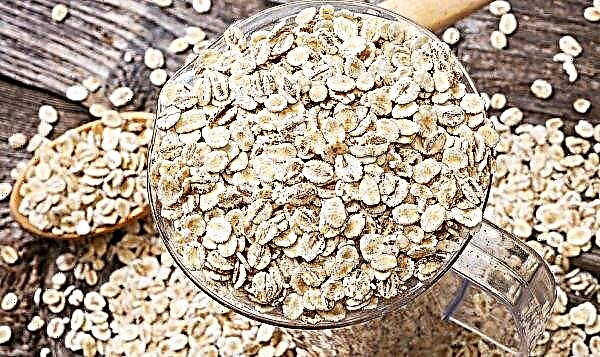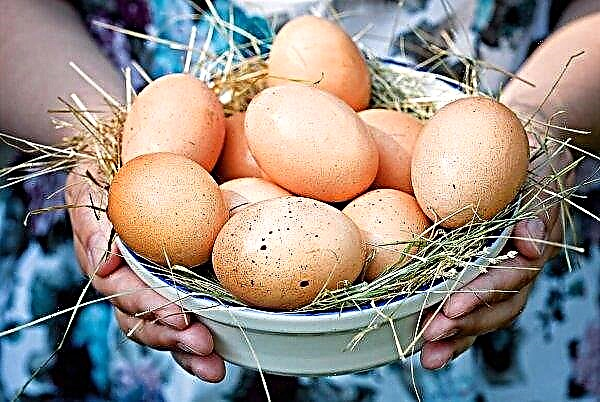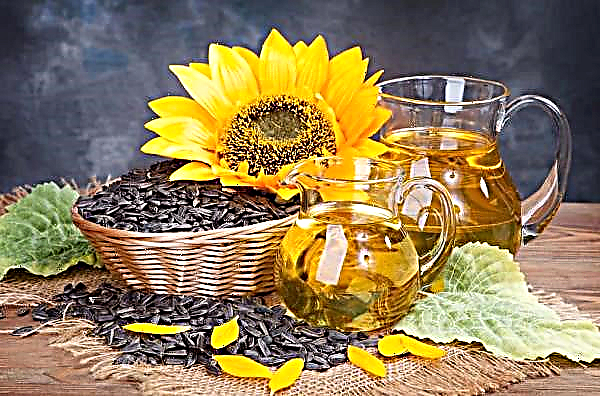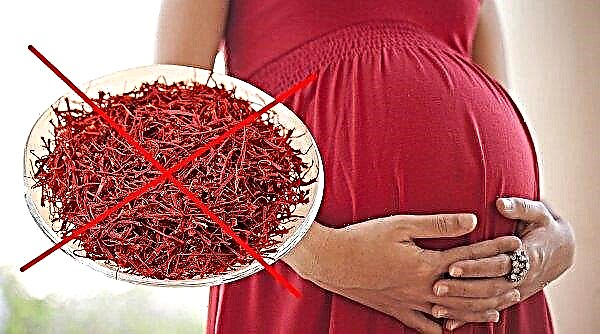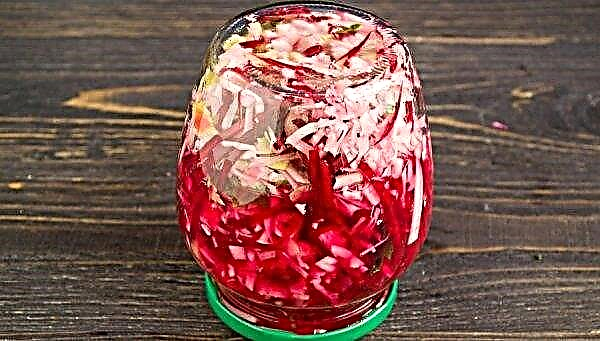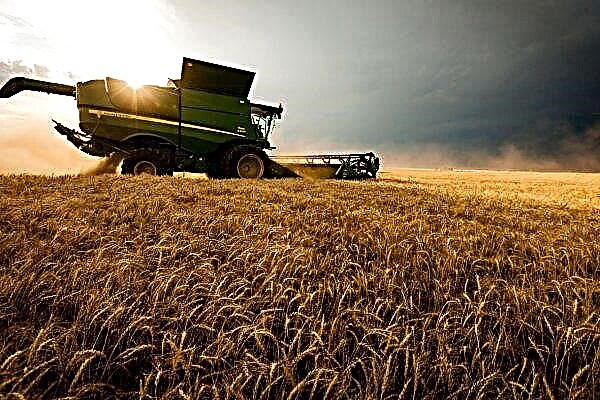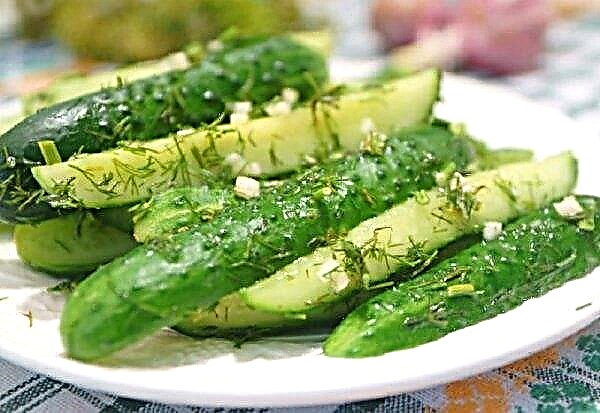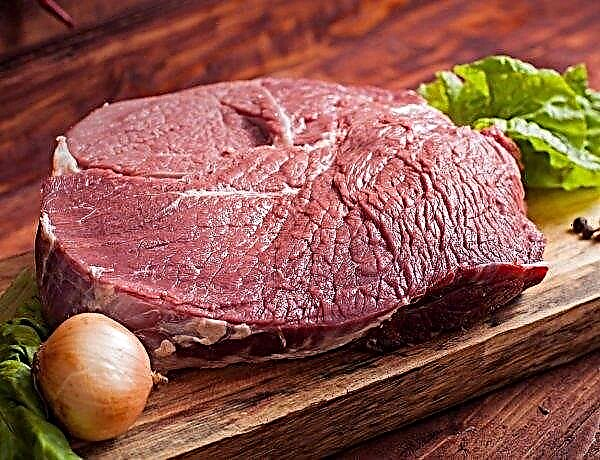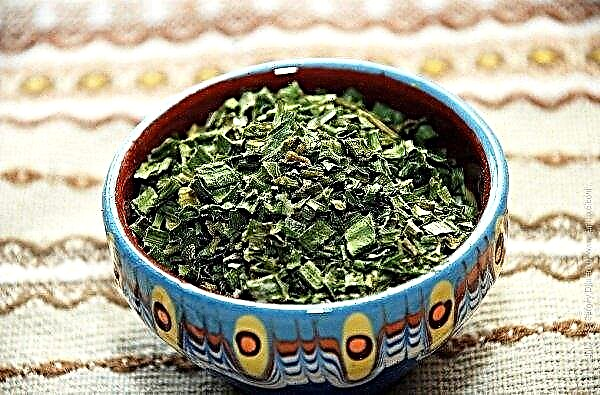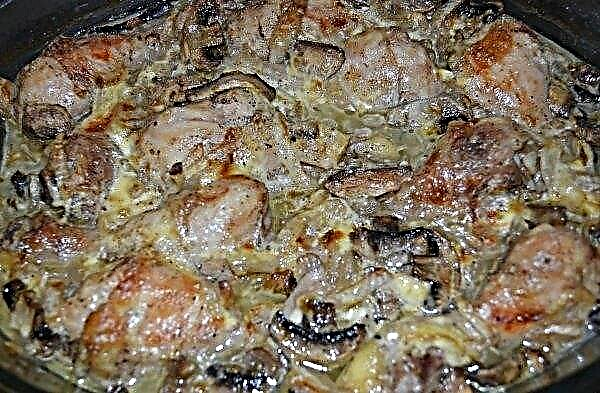At the height of the summer season, sweet and juicy cherries are in great demand. Therefore, gardeners set out to possibly extend the period of fruiting and began to breed medium-late varieties, which include Lapins sweet cherry. The main characteristics and features of this fruit tree are described in this article.
Botanical description and characteristics of cherries
Cherry Lapins was bred by Canadian breeders by crossing the elite varieties Stella and Van. Refers to self-fertile fruit trees, the ripening dates of which fall in the second half of July. Designed for cultivation in the southern regions, as it has medium resistance to frost.
Did you know? According to historians, the homeland of cherries is the Turkish city of Giresun, which means “Cherry”.
Characterization of fruits and tree
Lapins cherry trees are very tall, of medium height. The first few years are growing rapidly. The branches are directed upward, forming a spherical crown, which needs to be formed and trimmed. The leaves are light green in color, smooth, framed by small notches, densely cover the tree. The berries are quite large, round, saturated red, shiny, weighing 9-10 g, are well attached to the stalk. The pulp is pink, juicy, sweet, dense.
 Tasting evaluation of fruits is 4.8 points out of 5 possible
Tasting evaluation of fruits is 4.8 points out of 5 possible
Pros and cons of the variety
- Variety Lapins has the following positive qualities:
- gives a high yield;
- the fruits ripen at the same time;
- good presentation of berries;
- the fruits hold well on branches and do not crumble for a long time;
- excellent taste;
- universal use;
- contains a large amount of vitamins and other beneficial substances;
- trees do not take up much space on the site;
- can be transported over long distances.
- The disadvantages include:
- average frost resistance;
- instability to fungal diseases;
- exactingness to soil composition and humidity;
- the possibility of insect damage.
Pollinators and productivity
Cherry Lapins is considered a self-fertile variety, i.e., not requiring pollinators. She herself acts as a pollinator for other varieties of cherries and provides an increase in their productivity. The variety of cherries Lapins refers to high-yielding, because from 1 tree you can collect from 25 to 30 kg of ripe berries.
Important! If the rainy summer falls, the berries on the tree begin to rot.
Features of planting and care for cherries
To increase the yield of cherries, seedlings need to be planted in the right place. Also important is the care of the trees, which consists in regular watering, fertilizing, weeding weeds, loosening the soil and other activities.
Video: Planting and caring for cherries
Landing rules
You can plant Lapins cherries both in early spring and in autumn. But experts advise this event to be postponed to spring, since during an autumn planting a tree may not survive the winter, so it is better to prepare a hole for planting seedlings in the fall.
Choosing the best seedlings for planting
It is best to buy seedlings from trusted suppliers or in specialized nurseries. When choosing a tree, you need to pay attention to ensure that it does not have any damage, that it has no signs of decay or disease, and has a well-developed root system. The height of the seedlings should be from 80 cm (one-year) to 1 m (two-year).

Choosing a place to land
The best place for planting seedlings would be a well-lit, sunny, windless area, with a deep occurrence of groundwater (from 2 m). The soil should be loose, light, fertile, loamy or loamy. Since the Lapins variety is very sensitive to an excess of moisture (the roots begin to rot), it is better to avoid places with stagnant water in the ground or do drainage.
Landing process
Planting seedlings of cherries Lapins consists of the following steps:
- It is necessary to dig a landing pit with a depth of 80 cm and a width of up to 1 m.
- Between the pits leave a distance of 3 to 5 m.
- Pour a mixture of earth, humus, peat, 60 g of potassium sulfate, 100 g of superphosphate into a third hole, make a tubercle and drive in a stake to garter a seedling.
- Set a tree vertically on an elevation, straighten the roots.
- Pour part of the earth from above, condense, pour in 1 bucket of water, completely fill the soil, tamp.
- The root neck should protrude 5 cm to the ground.
- Around the trunk, make a hole, pour another bucket of water.
- Cover the trunk area with mulch.
- The tree is tied to a support.

Watering and feeding
In the first period after planting seedlings in a permanent place, they need to be watered once a week with heated, settled water. When the trees take root, watering can be reduced to 1 time per month. To retain moisture, you can cover the near-stem zone with mulch (peat, humus, compost).
The nutrients that were introduced during the planting of seedlings are enough for 3 years. Later, on the 4th year, holes of medium depth (25-30 cm) should be made along the periphery of the crown projection. In early spring, add 150-200 g of urea to them and pour water on top. In the second half of summer or autumn, pour 300 g of granular superphosphate and 100 g of potassium sulfate. On the 5th year in the spring, feed with ammophos (30 g per 10 l of water), in the fall - with organic fertilizers (20-30 kg of humus per 1 tree).
Cropping Methods
In order for the cherry Lapins to bear fruit well, it needs the formation of a crown. This can be done with special garden tools (garden shears, garden saw, delimbers, pruners, pruners, knives, etc.) and in several ways:
- formation in an australian bush - carried out during the planting of seedlings. The tree is cut to a height of 0.5 m. In summer, lateral shoots grow on the trunk, of which 4 pieces are left, the rest are cut. When the shoot reaches a length of 4-6 cm, a clothespin is clipped above its growth point parallel to the trunk. The following spring, all shoots knocked out of the crown structure are removed from the tree. If the shoot is skeletal, gentle first-order branches are left on it, which gives the cherries the shape of a fruit vase. The following year, young branches are cut on the crown of a tree to a length of 8–10 cm to thin it. Subsequent pruning consists in removing dry branches, damaged and diseased, adjusting the shape of the crown;
Video: Formation of cherries by the type of Australian bush
- spanish bush - carried out on a tree that was planted more than 1 year ago. It is cut to 40–70 cm. During the summer, branches 50–60 cm long grow on the trunk. Of these, the 4 strongest need to be selected and shortened 10–15 cm above the main trunk. The branches are tied to the pegs to adjust the inclination of the branches. In the fall, near the young trees, trellises are constructed, to which annual half-meter shoots are tied. A year after these manipulations, the branches are again cut. Shoots tied to trellises and annual shoots on the sides of the trunk are shortened to a quarter meter. Branches in the center of the crown and parallel to the ground do not touch;
Video: Formation of cherries by type of Spanish bush
- KGB method - It resembles the method of forming a Spanish bush, but differs from it by the location of fruiting areas. According to the Spanish method, vertical branches are permanent, and the formation of ovaries passes to renewable shoots and side branches. In the KGB system, on the contrary, the lateral branches do not develop, and the fruit grows on vertical shoots.
Video: KGB sweet cherry formation
Whitewash
An important step in the care of Lapins trees is the whitewashing of trunks. It is carried out in the fall. To do this, you must:
- in wet weather, carefully clean the trunk of moss or exfoliated bark, being careful not to damage it;
- whitewash with lime mortar, whitewash mix based on PVA glue or acrylic paint;
- you can use a spray bottle or a whitening brush;
- the height of the application of solutions should be 160–170 cm from the ground, since it is necessary to whiten the stem and lower skeletal branches.
Did you know? Eating cherries for food increases endurance, adds strength, helps to recover faster after physical exertion, therefore athletes like to eat them very much.
Winter preparations
Adult Lapins cherry trees do not need warming for the winter. But young or newly planted must be tied with burlap, agrofibre or other covering material that allows air to pass through. Dig the trunk area well, water and mulch. You can protect the trunks from rodents using a fine mesh.
Diseases and Pests
Lapins cherries are sensitive to certain fungal diseases and insects.
Important! Lapins cherries are very sensitive to solutions prepared from urea, which can burn the roots or crown of a tree, so they must be used very carefully, strictly adhering to the recommendations.
These include:
- moniliosis - a fungal disease that occurs in the form of wilting and drying of not yet developed leaves, flowers that do not fall. First, it affects young branches, then large ones. You need to fight with the help of spraying with the preparations “Chorus” (2 g per 10 l of water), “Topaz” (4 ml per 10 l of water) and the destruction of the affected branches;
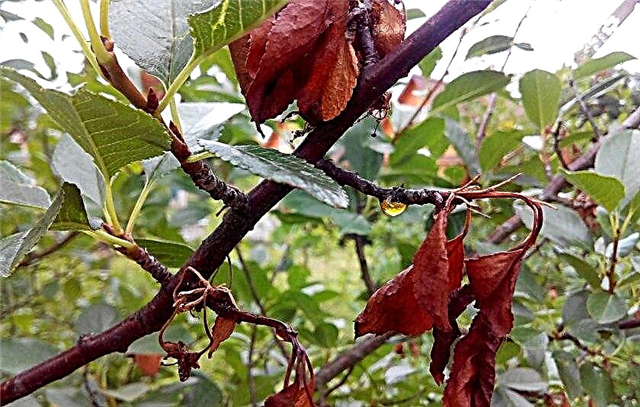
- kleasterosporiosis - completely infects the whole tree, but especially the foliage. It manifests itself as small round brown spots that grow with time. Then holes with a red border appear in the center of the spots. For prevention, you need to burn diseased areas of the tree, and also use the Nitrafen (200 g per 120 l of water working solution), Aktara (4 g per 10 l of water), copper sulfate;
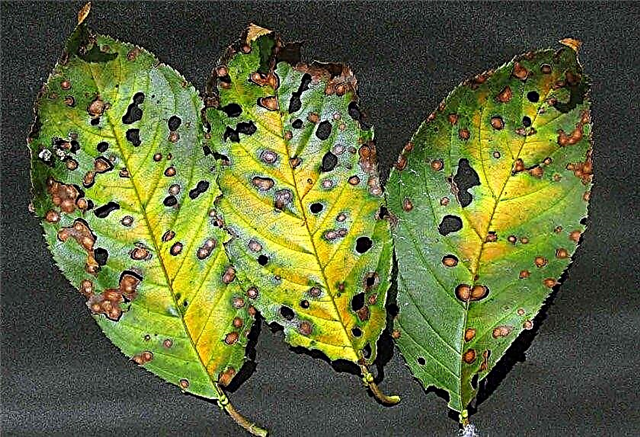
- cherry fly - an insect with transparent wings on which there are three transverse stripes. It feeds on the juice of sweet cherry berries, lays eggs in the fruits, from which white small larvae are eaten, eating the flesh. It is recommended to dig up the near-trunk zone, where the pest eggs are located. Against a fly, such agents as Actellik (12 ml per 10 l of water), Calypso (2 ml per 10 l of water), Zolon (2 ml per 5 l of water), etc. will be effective;
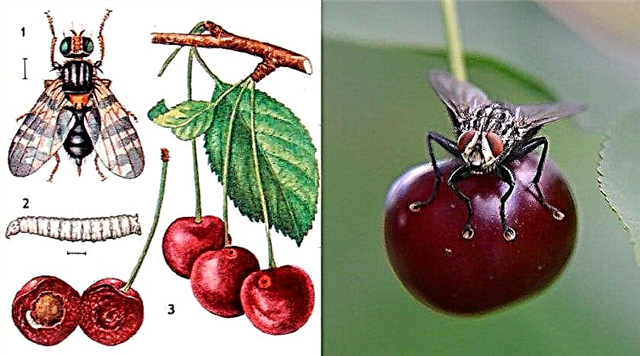
- winter moth - the main pest is a caterpillar devouring buds and buds that have not yet opened, pulling them together with a thin cobweb. To destroy the pest use "Boverin", "Metarizin" (250 ml per 10 l of water);

- goldfish - a white butterfly with a golden abdomen completely eats cherry leaves, forms a dense web in the form of a nest, where it transfers winter. Mechanical methods include the removal of insect nests from branches or the use of pheromone traps. Chemicals include spraying with preparations “Karbofos” (10% solution), “Antilin” (25 g per 5 l of water), “Lepidocide” (30 g per 10 l of water).
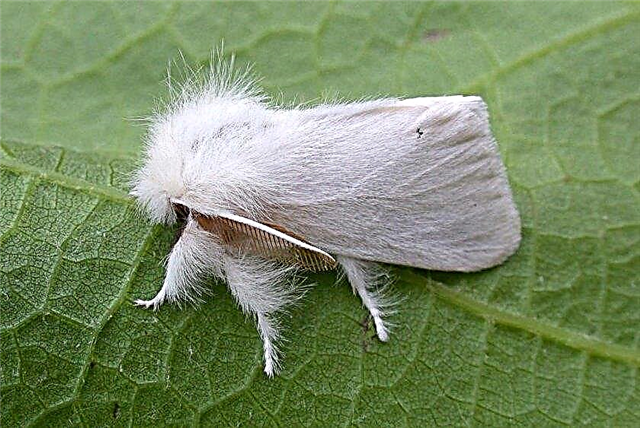
Harvesting and storage
Harvesting falls in the second half of July. Sweet cherry should be picked from the stem for its best storage. Picked fruits should be carefully placed in a box or other container. You can’t throw berries. The optimum storage temperature for Lapins cherries is 0 ... + 4 ° C. In such conditions, the crop can be saved for 1-2 weeks.
 You can only store high-quality and undamaged fruits, which must be periodically checked and discarded damaged
You can only store high-quality and undamaged fruits, which must be periodically checked and discarded damaged
Despite some capriciousness of Lapins cherries, gardeners recommend growing it on their sites, because it has high taste, high yield, and is widely used.
Network user reviews
I have been growing and bearing fruit for 10 years already. I’m satisfied with sweet cherry. Vaccinated on antipka. It grows together well. Himself vaccinated on antipka, no problem. That it is not hardy is exaggerated. She calmly endured frosts without loss at a young age - 30. This year there was a freeze on flowering, down to -5. From the bottom to the middle of the crown, the color turned yellow, and there are fruits on top, but not much. The only serious disease is coccomycosis. Very susceptible. No treatment in any way. Self-dusting. Checked.






